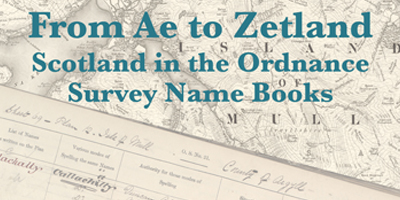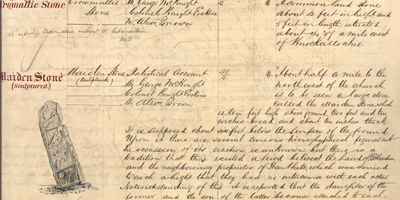Ordnance Survey Name Books
Ordnance Survey Name Books

A secret cave, a witch's bridge and the Scott Monument are among the fascinating places featured in this free display at the National Records of Scotland from 6 December to 31 January 2014. This marks the completion of a project to digitise this series of 1,688 books and make them available on the ScotlandsPlaces website.
The Ordnance Survey Name books contain every place name that appeared on Victorian maps of Scotland and can now be searched by the public online. The books are also being linked to the relevant Ordnance Survey map to allow connected searching for the first time.
The name books were created by the Ordnance Survey's field surveyors as they mapped Scotland from the 1840's until 1878, when they completed their work on Orkney and Shetland. The surveyors compiled name books to record information about the names of every natural feature and man-made structure that was to appear on the maps. They relied on knowledgeable locals of all classes to supply them with accurate names. Their instructions were to consult landowners and their agents first, then other people of standing such as parish ministers and school teachers. In practice, and especially in remoter areas, they turned to humbler people such as tenants, shepherds and labourers. In Gaelic-speaking areas they sometimes worked through interpreters.
The surveyors added notes from printed histories, gazetteers, directories and dictionaries making the name books a snapshot of the landscapes and townscapes of Scotland. They can be studied online along with the maps to which they relate.

Cabinet Secretary for Culture and External Affairs, Fiona Hyslop, said:
"ScotlandsPlaces is a wonderful resource, and the welcome addition of the Ordnance Survey Name Books makes it an even more exciting gateway for Scots, those of Scottish descent, and anyone with an interest in Scotland, to explore our nation's history and landscape."
Chief Executive of the National Records of Scotland, Tim Ellis, said:
“I’m delighted to be making available online more of the great records that we hold in the National Records of Scotland. The Ordnance Survey Name Books are a rich resource for research into the history of places throughout Scotland and a treasure trove of fascinating insights. I’m pleased to be working closely with our partners RCAHMS and the National Library to add new historical resources to the ScotlandsPlaces website. Our free display in NRS allows visitors to learn more about these and other fascinating historical records that we hold.
RCAHMS Head of Education and Outreach, Rebecca Bailey, said:
"The OS Name Books are an incredible source of information about Scotland - a nineteenth century equivalent of our modern internet search engines. These were the key reference works for anyone wanting to find out about the landscapes, buildings and places of Scotland. This exhibition helps to celebrate the logical evolution of the Name Books - which have been brought in the twenty-first century by being digitised and made available online.'
'When combined with the other material already available on the ScotlandsPlaces website – including hundreds of thousands of photographs, plans and architectural drawings of Scotland’s buildings from the RCAHMS archive, and maps from the National Library of Scotland – it allows for a wonderfully rich study of our history."
Dr Simon Taylor, who researches and teaches toponymics (place name studies) at the University of Glasgow said:
"In the OS Name Books Scotland possesses a unique resource for understanding the evolution of Scotland’s complex place-nomenclature, as well as nineteenth-century perceptions of place, language, environment, archaeology and culture. ScotlandsPlaces, by making them so widely and easily accessible, has opened up a treasure-trove of material for local and national historians, both lay and academic."
NRS acknowledges the kind cooperation of our partners in ScotlandsPlaces, Royal Commission on the Ancient and Historical Monuments of Scotland and the National Library of Scotland.
 'Explore your Archive' is a nationwide campaign to raise awareness of archives, their value to society and the impact they have, every day, on individual lives.
'Explore your Archive' is a nationwide campaign to raise awareness of archives, their value to society and the impact they have, every day, on individual lives.